Abstract
The purpose of this study was to establish the validity and reliability of a hydrostatic weighing method using total lung capacity (measuring vital capacity with a respirometer at the time of weighing) the prone position, and a small oblong tank. The validity of the method was established by comparing the TLC prone (tank) method against three hydrostatic weighing methods administered in a pool. The three methods included residual volume seated, TLC seated and TLC prone. Eighty male and female subjects were underwater weighed using each of the four methods. Validity coefficients for per cent body fat between the TLC prone (tank) method and the RV seated (pool), TLC seated (pool) and TLC prone (pool) methods were .98, .99 and .99, respectively. A randomised complete block ANOVA found significant differences between the RV seated (pool) method and each of the three TLC methods with respect to both body density and per cent body fat. The differences were negligible with respect to HW error. Reliability of the TLC prone (tank) method was established by weighing twenty subjects three different times with ten-minute time intervals between testing. Multiple correlations yielded reliability coefficients for body density and per cent body fat values of .99 and .99, respectively. It was concluded that the TLC prone (tank) method is valid, reliable and a favourable method of hydrostatic weighing.
Full text
PDF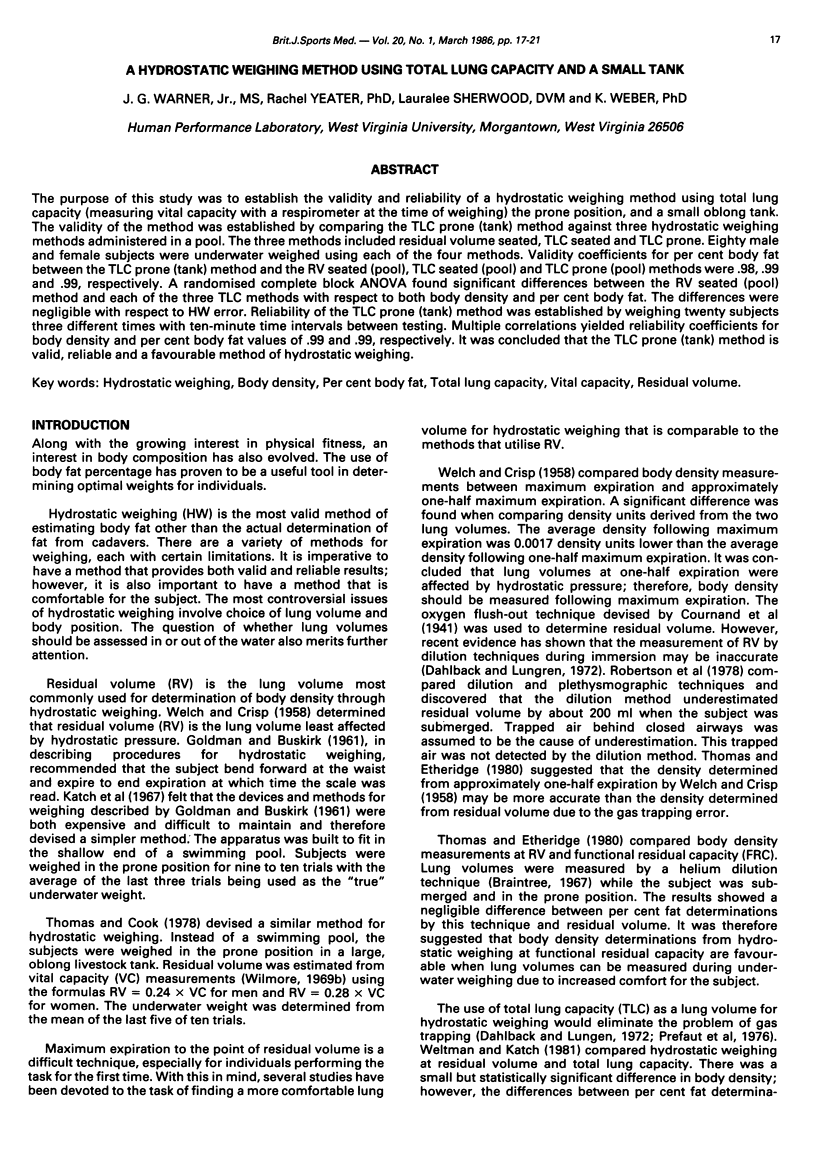
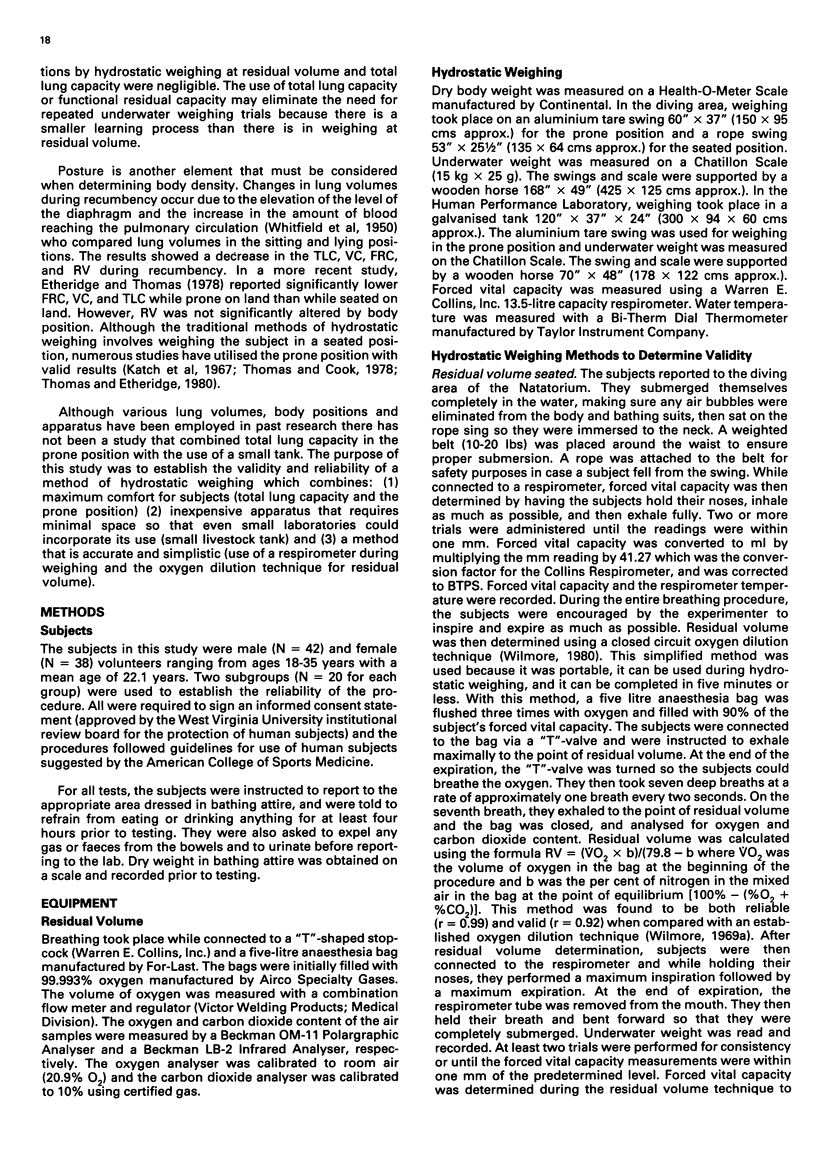
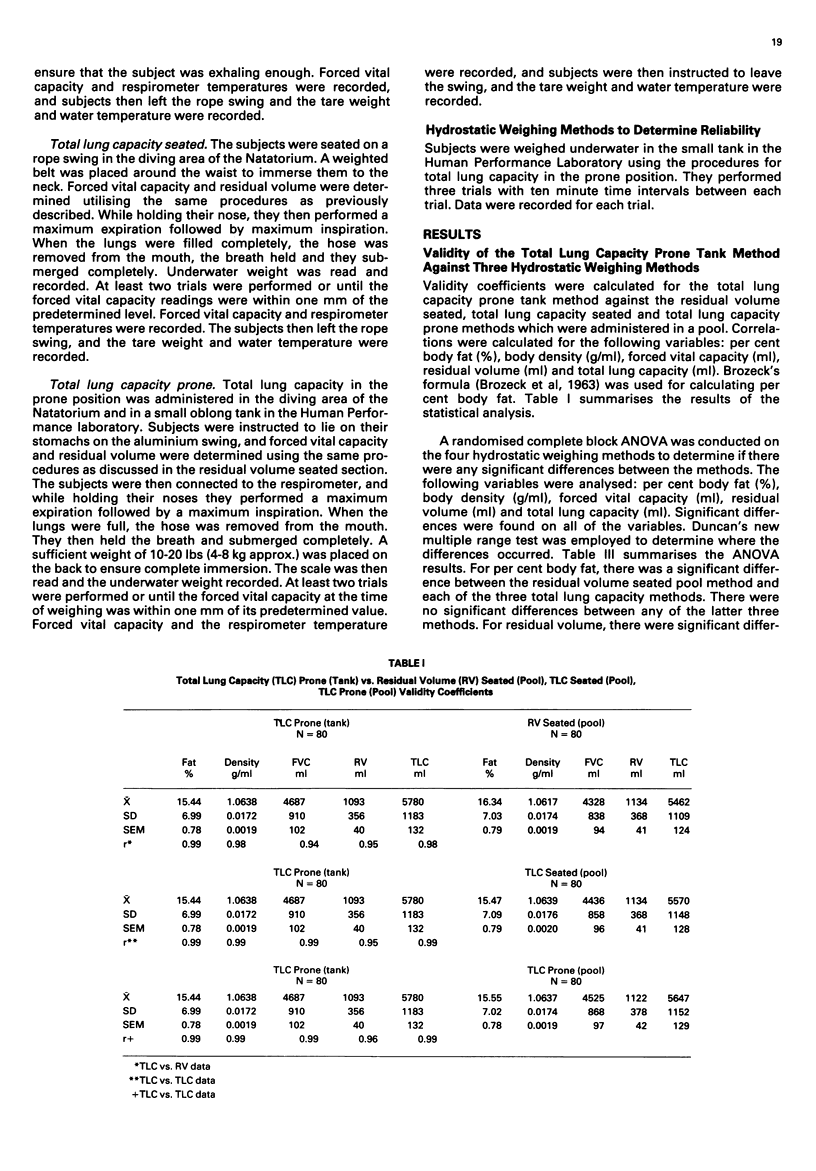
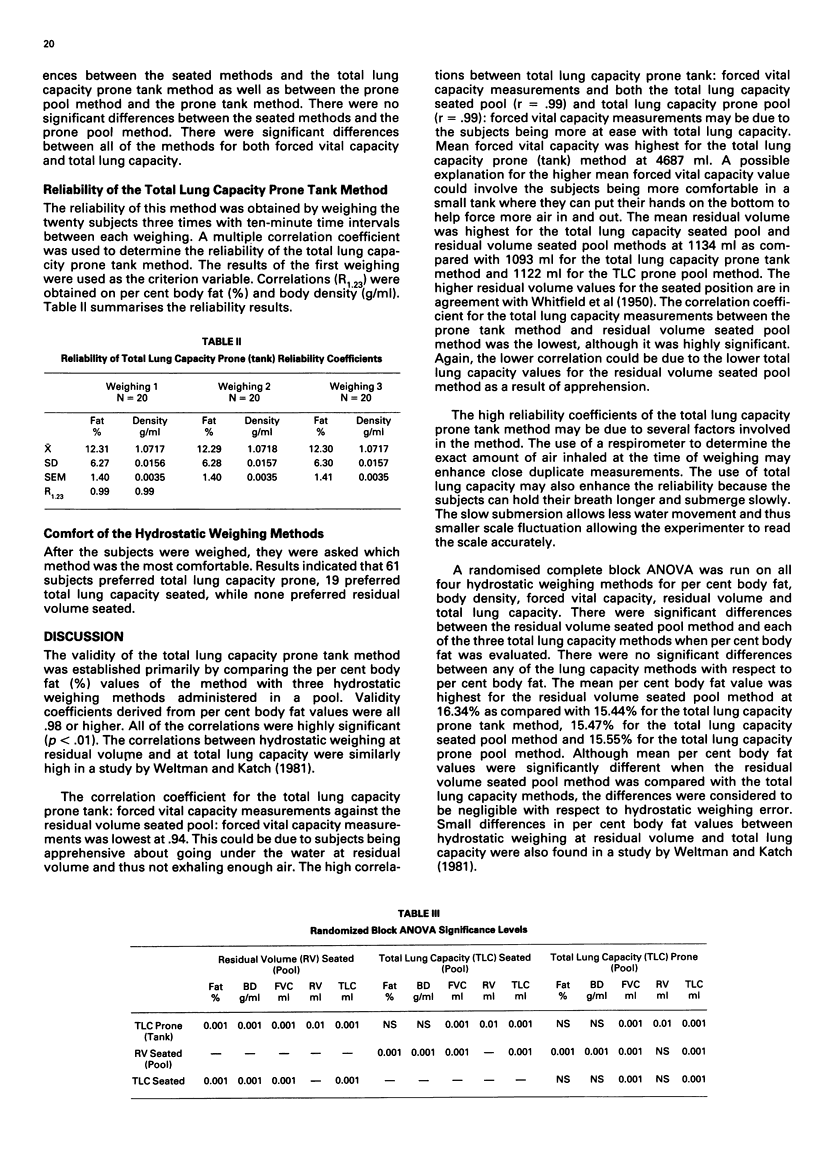
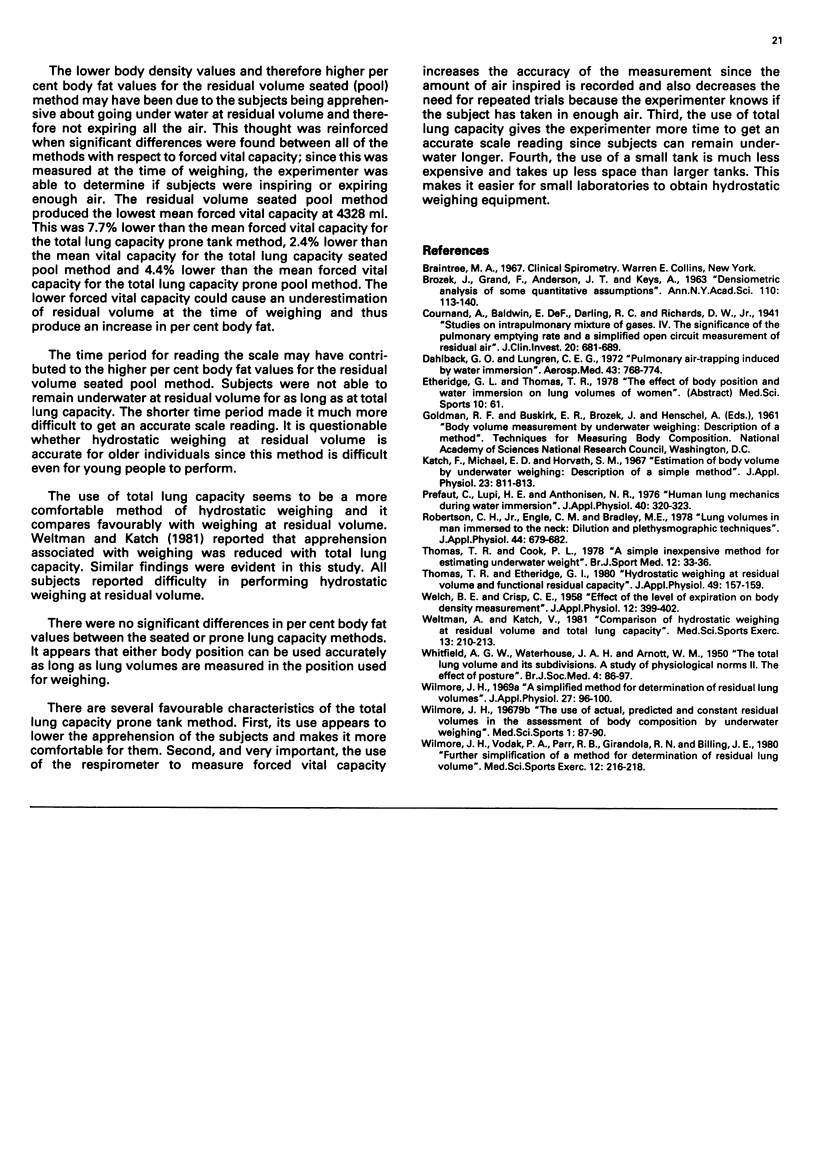
Selected References
These references are in PubMed. This may not be the complete list of references from this article.
- BROZEK J., GRANDE F., ANDERSON J. T., KEYS A. DENSITOMETRIC ANALYSIS OF BODY COMPOSITION: REVISION OF SOME QUANTITATIVE ASSUMPTIONS. Ann N Y Acad Sci. 1963 Sep 26;110:113–140. doi: 10.1111/j.1749-6632.1963.tb17079.x. [DOI] [PubMed] [Google Scholar]
- Cournand A., Baldwin E. D., Darling R. C., Richards D. W. STUDIES ON INTRAPULMONARY MIXTURE OF GASES. IV. THE SIGNIFICANCE OF THE PULMONARY EMPTYING RATE AND A SIMPLIFIED OPEN CIRCUIT MEASUREMENT OF RESIDUAL AIR. J Clin Invest. 1941 Nov;20(6):681–689. doi: 10.1172/JCI101261. [DOI] [PMC free article] [PubMed] [Google Scholar]
- Dahlback G. O., Lundgren C. E. Pulmonary air-trapping induced by water immersion. Aerosp Med. 1972 Jul;43(7):768–774. [PubMed] [Google Scholar]
- Katch F., Michael E. D., Horvath S. M. Estimation of body volume by underwater weighing: description of a simple method. J Appl Physiol. 1967 Nov;23(5):811–813. doi: 10.1152/jappl.1967.23.5.811. [DOI] [PubMed] [Google Scholar]
- Prefaut C., Lupi-h E., Anthonisen N. R. Human lung mechanics during water immersion. J Appl Physiol. 1976 Mar;40(3):320–323. doi: 10.1152/jappl.1976.40.3.320. [DOI] [PubMed] [Google Scholar]
- Robertson C. H., Jr, Engle C. M., Bradley M. E. Lung volumes in man immersed to the neck: dilution and plethysmographic techniques. J Appl Physiol Respir Environ Exerc Physiol. 1978 May;44(5):679–682. doi: 10.1152/jappl.1978.44.5.679. [DOI] [PubMed] [Google Scholar]
- Thomas T. R., Cook P. L. A simple inexpensive method for estimating underwater weight. Br J Sports Med. 1978 Mar;12(1):33–36. [PMC free article] [PubMed] [Google Scholar]
- Thomas T. R., Etheridge G. L. Hydrostatic weighing at residual volume and functional residual capacity. J Appl Physiol Respir Environ Exerc Physiol. 1980 Jul;49(1):157–159. doi: 10.1152/jappl.1980.49.1.157. [DOI] [PubMed] [Google Scholar]
- WELCH B. E., CRISP C. E. Effect of the level of expiration on body density measurement. J Appl Physiol. 1958 May;12(3):399–402. doi: 10.1152/jappl.1958.12.3.399. [DOI] [PubMed] [Google Scholar]
- WHITFIELD A. G. W., WATERHOUSE J. A. H., ARNOTT W. M. The total lung volume and its subdivisions; a study in physiological norms; the effect of posture. Br J Soc Med. 1950 Apr;4(2):86–97. [PMC free article] [PubMed] [Google Scholar]
- Weltman A., Katch V. Comparison of hydrostatic weighing at residual volume and total lung capacity. Med Sci Sports Exerc. 1981;13(3):210–213. doi: 10.1249/00005768-198103000-00012. [DOI] [PubMed] [Google Scholar]
- Wilmore J. H. A simplified method for determination of residual lung volumes. J Appl Physiol. 1969 Jul;27(1):96–100. doi: 10.1152/jappl.1969.27.1.96. [DOI] [PubMed] [Google Scholar]
- Wilmore J. H., Vodak P. A., Parr R. B., Girandola R. N., Billing J. E. Further simplification of a method for determination of residual lung volume. Med Sci Sports Exerc. 1980;12(3):216–218. [PubMed] [Google Scholar]


